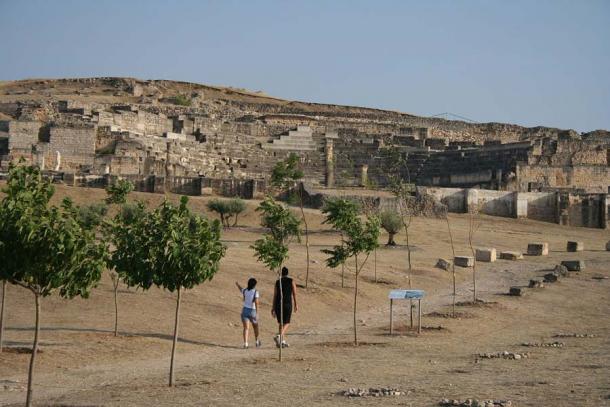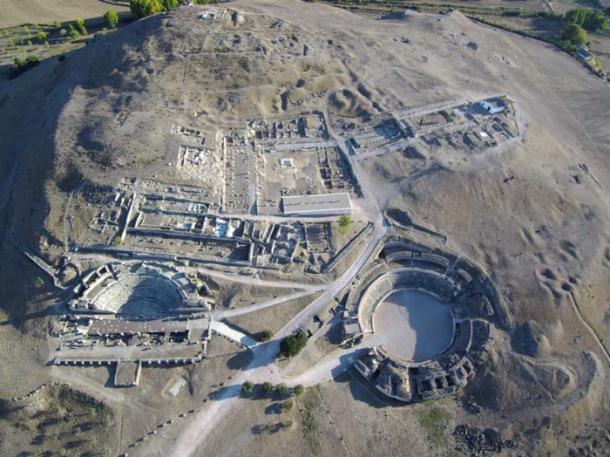Segóbriga was a Celtic, and later Roman, city located in Castilla-La Mancha, in the central part of Spain. Today, the ancient city is an important archaeological park and one of the best-preserved in Spain’s Meseta Central. Segóbriga is most notable for its Roman theatre and amphitheatre, which are located on the fringe of the site. Nevertheless, there are also other impressive ruins at the archaeological park that date to different periods of the site’s occupation.
Important Segóbriga Ruins Discovered in 1888
The name Segóbriga is a combination of two Celtiberian words, segó and briga, which mean “victory” and “city” or “fortress”. Therefore, the name of the settlement translates roughly to mean “City of Victory.” The ancient settlement is situated on a hill called Cabeza del Griego (literally translates to mean “Greek Head”), not far from the modern town of Saelices. The site is located in the Meseta Central (meaning “Central Tableland”), a plateau that covers a large part of the interior of the Iberian Peninsula, including the region of Castilla-La Mancha .
The site of Segóbriga was first discovered in 1888, when a collection of Celtiberian burials was discovered inside a cave near Saelices. The burials, which contain both human remains and artefacts, were dated to the 2 nd millennium BC. This means that human beings were already in the area as early as the Bronze Age. In the years that followed, other archaeological remains were discovered at the site. It is believed that Segóbriga was originally a Celtiberian settlement. Unfortunately, there is not much information available about this period of Segóbriga’s history.

Roman theater at Segóbriga in Castilla-La Mancha. (Josemanuel / CC BY-SA 2.5 )
Grand Roman Ruins of Segóbriga
The Roman phase of the site’s history is better documented, both in the archaeological and literary sources. As an example, Segóbriga is briefly mentioned by the Strabo, the famous Greek geographer who lived during the Roman period . Strabo wrote that Segóbriga was a Celtiberian settlement, and that “Metellus and Sertorius had their war” near this city. Segóbriga is also mentioned by Pliny the Elder , who wrote that lapis specularis , a type of gypsum, was quarried in the area surrounding the city. Apart from the mining of this mineral, Segóbriga also prospered from agriculture and trade, the latter facilitated by its strategic location between Carthago Nova and Toletum Segontia.
The grandeur of Roman Segóbriga is attested by the ruins of the city’s theatre and amphitheatre, both of which are located on the northern fringes of the city, overlooking a valley. It is estimated that the amphitheatre was able to accommodate up to 5,500 spectators. Other notable Roman ruins that are visible in the archaeological park today are the city walls and its gates, two bath complexes, and the forum. Additionally, during the 2 nd century AD, a circus for chariot-racing was built in the city. In order to construct this new building, however, part of an older necropolis had to be destroyed.
Incidentally, a study of the city’s water supply was carried out during the 1970s by M. Almagro Basch. The Roman inhabitants of Segóbriga obtained their water from aqueducts, and some of the interesting findings of Almagro Basch’s study include the use of lead pipes for the distribution of water inside the city, and the way the underground water catchment gallery worked.

The archaeological park at Segóbriga near Saelices is well worth a visit. ( VEOy.com / Adobe Stock)
Decline of Segóbriga and the Crisis of the Roman Empire
Although the 3 rd century AD as a period of crisis in the Roman Empire, Segóbriga seems to have not been as badly affected as many other areas in the Empire. According to the archaeological evidence, there were still a number of elites living in the city during these tumultuous times. Nevertheless, it is clear that the city was in decline. The situation only became worse in the century that followed. By the 4 th century AD, the city’s main monuments had been abandoned and most of Segóbriga’s inhabitants had relocated to nearby Saelices.
Still, there were people living in Segóbriga during the subsequent Visigothic period , in the 5 th century AD, even though the city was now a rural town. The remains of a Visigothic basilica in the archaeological park is testament to the habitation of Segóbriga during this period. It is estimated that the final abandonment of Segóbriga occurred during the Islamic conquest of Spain during the 8 th century AD.
The significance of Segóbriga is evident in its declaration as a National Monument in 1931. The site, as already mentioned, is one of the best-preserved archaeological sites in the Meseta Central, and is therefore an important window to the area’s ancient past. The archaeological park is open form Tuesdays to Sundays, and there is an entrance fee to the site.
Top image: Segóbriga is one of the best-preserved Roman cities in the Spanish Meseta Central in Spain. Source: Tolo / Adobe Stock
By Wu Mingren
 RSS Feed
RSS Feed















 February 9th, 2021
February 9th, 2021  Awake Goy
Awake Goy  Posted in
Posted in  Tags:
Tags: 













